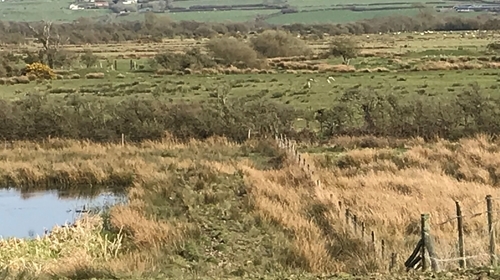
The bird which GWCT is probably most associated with is the Grey partridge yet in Wales we have very few left. After the loss of much of our mixed farming in the 1980’s when it became cheaper to buy our concentrates onto the farm rather than doing battle with combining crops on marginal land, in potentially adverse weather conditions in small fields. I remember our combine getting bogged down to i’s belly on Malltraeth Marsh in the early 80’s but despite this relatively intensive production I also remember lapwing nesting and driving around their nests when cultivating every year. You would think that the extensification of farming on the marsh that has followed in the area would have resulted in more numbers, but I haven’t seen a lapwing for many a year.
Like so much of life not only is it a Question of Balance as GWCT’s 1991 book proclaimed but also diversity that seems important. Our farming systems have become focused on a single enterprise at the expense of diversity. This is even more evident in other parts of the world such as California where I gather you can drive for hundreds of miles of Almonds and orange groves without a bug or a bird to be heard.
So now with a new Welsh Government coming together, will we manage to persuade them of the complexities of increasing biodiversity on our farms alongside addressing other issues such as climate change and social health and wellbeing within a sustainable business?
The grey partridge is even more reliant on combinable crops so what is our chances of them thriving again in Wales alongside the lapwing and other declining species.
So I asked our own expert scientist in grey partridge Dr Francis Buner who leads the EU wide PARTIRDGE Project, “Many people are keen to get grey partridge re-established in Wales. Though we have lost much of our mixed farming there is great belief that this can still be done. What do you reckon to our chances? “
And he replied “The chances to get grey partridges re-established in Wales are very slim I’m afraid. Few things are impossible in this world, but this one will be very difficult indeed.
To get the greys back on a good footing in Wales the following things need to happen:
- Concentrate your efforts on those areas where they still exist (see maps attached) - in particular the Isle of Anglesey. There, all efforts should be concentrated on farmland habitat improvements together with predation management. It is the last Welsh stronghold there is.
- Assist the other handful of places where partridges still exist (see map) to get into an AES Scheme (aim at min. 7%-10 high-quality measures) and launch farmer clusters around these farms with the grey as one of their main farmland key species they hope to recover. Where partridges have been reduced to tiny, fragmented populations it is only a matter of time before they will go extinct, and on single farms they are extremely unlike to persists over an extended period of time. So, expanding what is left should be the focus, again based on a tailored habitat management and predation management strategy.
- Lastly, releasing greys in areas where they have disappeared, and which are predominantly in grass for livestock is pointless I am afraid. Without 50% of the area in arable they virtually stand no chance to settle for the long-term. I would say, before the farming in these areas doesn’t change back to mixed farming, re-establishing efforts are a waste of time and money and will only end in disappointment in 98% of the cases (there are always exceptions where it might work, but knowing where these 2% are, is impossible to tell in advance without trying).”
So, let us broaden the conversation from trees and extensification to broader diversity in the countryside. I love a seemingly impossible challenge so I think we should have a go - it would be lovely to see grey partridge in such abundance again.
Useful Links: